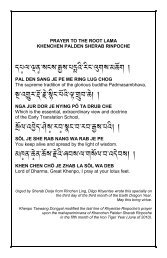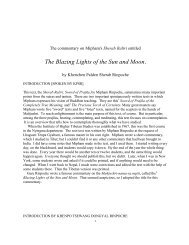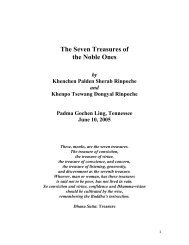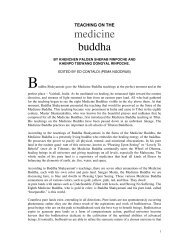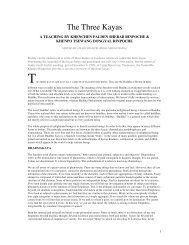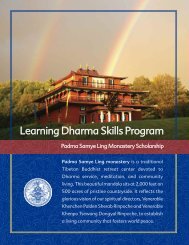6 Pema Mandala Spring 07:Pema Mandala - Padmasambhava ...
6 Pema Mandala Spring 07:Pema Mandala - Padmasambhava ...
6 Pema Mandala Spring 07:Pema Mandala - Padmasambhava ...
Create successful ePaper yourself
Turn your PDF publications into a flip-book with our unique Google optimized e-Paper software.
to bring forth the dense power of bodhichitta in both our hearts<br />
and minds. In his teachings, the Buddha often said, “Without<br />
compassion, the root of Dharma is rotten.” Without compassion,<br />
the essence of the teachings is lost. In other words, bodhichitta<br />
is the very essence of the Dharma: compassion is the<br />
essence of our practice. Along with love, kindness, and compassion,<br />
the teachings often speak of the Four Boundless thoughts,<br />
which are sympathetic joy and equanimity, in addition to this<br />
love and compassion. Bodhichitta is truly one of the most<br />
important aspects of our practice. Practicing in this way will definitely<br />
sharpen all our Dharma-related activities.<br />
The third attitude that will sharpen our practice includes<br />
devotion and faith. This is also known as taking refuge,<br />
which is a foundation of all schools of Buddhism. Our practice<br />
will not activate without these two qualities, which are<br />
closely linked. “Devotion” refers to both trust and confidence,<br />
along with a feeling of comfort and closeness towards<br />
the Three Jewels, the Three Roots, and one’s innate nature.<br />
Devotion and faith will make us feel happy and joyful<br />
towards practice. We have all received authentic practices,<br />
so we have everything we need. We can be confident that<br />
nothing is missing from the teachings we have been given,<br />
and there is no shortage of practices we can do!<br />
Although we already have everything we<br />
need to progress along the path, our practice is<br />
lacking. Why Because we are not using what<br />
we already have. We are not activating our<br />
renunciation, bodhichitta, devotion, and faith.<br />
Therefore, we should continue to develop our<br />
close connection with the Buddha, Dharma,<br />
and Sangha, as well as Guru <strong>Padmasambhava</strong><br />
and the lineage. This connection takes the<br />
form of a strong feeling of devotion, joy, closeness,<br />
and warmth. Trust and confidence are<br />
also very important. For all these reasons, devotion—which<br />
actually includes trust and confidence—will really help to<br />
sharpen our practice of meditation. It will help enhance all our<br />
activities, quickly bringing results. We could say that devotion<br />
is almost like adding Miracle Grow to our practice! Truly, it is<br />
essential for our growth. So, increasing our devotion, faith, and<br />
closeness towards the Buddha, Dharma, Sangha, and the lineage,<br />
with feelings of closeness and joy are part of the third attitude<br />
that will help to sharpen our practice.<br />
The next important attitude that will restrengthen our practice<br />
includes mindfulness, alertness, and attentiveness, or<br />
thoughtfulness. These qualities are all extremely important.<br />
One of the aims of Dharma practice, and Buddhism in general,<br />
is to improve ourselves. This means we need to improve and<br />
enhance our love, compassion, and wisdom. At the same time,<br />
we are trying to reduce the strength and degree of our ego-clinging<br />
and negative emotions. The only way to do this is to look<br />
at ourselves, instead of always watching others and judging<br />
what they do; we are not the watchmen of other people. Thus,<br />
as Buddhist practitioners we have to watch our own minds and<br />
actions, instead of constantly analyzing the actions of others.<br />
This is known as mindfulness and alertness.<br />
Simultaneously, we must develop our patience. We should<br />
not immediately place blame on others, thinking that we ourselves<br />
are completely perfect. Putting down others and pointing<br />
out their shortcomings is a sign of weakness in a practitioner.<br />
Rather than cling to this narrow view, we should activate our<br />
patience, our alertness, and our mindfulness. This will help us<br />
settle down so that we ourselves can really grow and develop.<br />
This is the next important technique that will strengthen our<br />
practice—looking to both ourselves and others with patience.<br />
In order to increase our patience, it is necessary to examine<br />
our own errors and faults with the intention of removing and<br />
purifying them. We should think, “I am not the perfect one<br />
here. I am not perfect.” With this motivation, we are trying to<br />
develop our good qualities, our inner perfection, so that we will<br />
eventually become good examples to others and be able to benefit<br />
them. We ourselves will generate these qualities, thus<br />
becoming good practitioners. Patience and mindfulness are also<br />
excellent ways to increase our awareness in post-meditation;<br />
they will really help expand our bodhichitta.<br />
In Tibet, it is often said that it is wonderful if<br />
you can put a handprint or footprint in rock,<br />
but even more wonderful if you are always<br />
patient, loving, gentle, and peaceful.<br />
Next, joyful effort is one of the most important qualities<br />
we can cultivate in order to sharpen our practice. It is truly<br />
so important. Joyful effort is not something we can generate<br />
once in awhile, or every now and then. We cannot limit our<br />
practice to those times when we are feeling good, when<br />
things are going our way. Neither should we practice only<br />
when we experience difficulties and are going through<br />
rough times. It is crucial that we continue to practice until<br />
we fulfill the goal of complete enlightenment by fully developing<br />
our love, compassion, and wisdom.<br />
Achieving the goal of supreme enlightenment for the benefit<br />
of all living beings is only possible by removing each and<br />
every one of our negative emotions, which serve only to harm<br />
ourselves and others. As a result, we must continue to practice<br />
until we are free from all afflictive emotions—until we are no<br />
longer bothered by adverse circumstances. For example, we<br />
must practice until we do not become the slightest bit upset or<br />
irritated when somebody criticizes us. Similarly, we should prac-<br />
SPRING/SUMMER 20<strong>07</strong> | <strong>Pema</strong> <strong>Mandala</strong> 9




